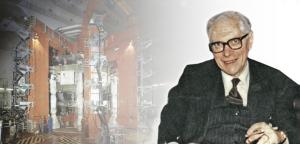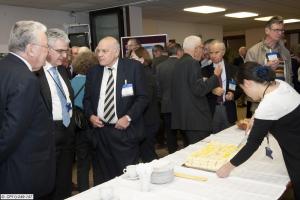Donato Palumbo (1921-2011), a fusion visionary
2 Dec 2011
-
Jean Jacquinot, former director of JET
Palumbo promoted the novel scheme of associating fusion laboratories across Europe in order to provide strong incentive for collaborative research activities. © EFDA
The visionary "father" of the European fusion program, Donato Palumbo, passed away on 8 February 2011; this past week a heartfelt commemoration of his life and his professional legacy was organized at JET.
Family, friends, European lab directors, and colleagues gathered in the auditorium to share memories. Umberto Finzi remembered the distinguished scientist who made very original contributions on magnetohydrodynamic (MHD) equilibrium. Others evoked his career in Brussels where for 30 years he was a key director of the Euratom program.
Rather than trying to bring fusion research into the framework of existing joint research centres, Palumbo had promoted the novel scheme of associating fusion laboratories across Europe in order to provide strong incentive for collaborative research activities. This program promoted the mobility of scientists and encouraged each national lab to concentrate on the resolution of particular issues for fusion. CEA was the first institution to join, but soon all the European labs that were active in fusion signed contracts of association with Euratom. The scheme was a resounding success and is still in effect today.
Paul-Henri Rebut recollected how, after 1968, Palumbo steered the European fusion program towards toroidal devices and conceived JET, a machine that represented a huge leap forward in size and where each key parameter such as current and power was increased by more than a factor 10 over existing devices at that time. Palumbo, with his low-key attitude but his highly innovative style, created the JET Joint Undertaking. Constructed as a private enterprise, it provided 'high efficiency with minimum bureaucracy.' He personally took part in its management.
Three "heavyweights" of fusion research during the commemoration event for Palumbo: Robert Aymar, Francesco Romanelli and Paul-Henry Rebut (from left).© EFDA
Asked by Queen Elizabeth during the JET inauguration how he could have put together such a huge enterprise so successfully, the often facetious Palumbo answered casually: "By disobeying..., your Majesty."
Romano Toschi went on to recall Palumbo's creation of NET (Next European Torus). Installed in Garching, Germany, the NET team was to prefigure a fully international follow-up to JET, leading naturally to the ITER conceptual design and engineering design phases.
Romano Toschi went on to recall Palumbo's creation of NET (Next European Torus). Installed in Garching, Germany, the NET team was to prefigure a fully international follow-up to JET, leading naturally to the ITER conceptual design and engineering design phases.
Finally, Catherine Cesarsky, the French high commissioner for atomic energy who is presently the chair of the CCE-FU (the European committee for fusion energy) returned to the essential role of Palumbo's fusion associations. She stressed how he stayed very close both to the managers but also to the scientists. It reminded me of how, when I was a young researcher, Palumbo phoned to enquire about details of MHD calculations I had recently published. I learned then that (in his spare time) he was working on the same subject.
No doubt, those present felt a profound admiration for the charming man who never departed from a modest attitude but who had been tremendously successful at establishing a well-coordinated fusion program with a strict minimum of bureaucracy. Scientific competence was an essential ingredient to his success.
Let us wish that his legacy prevails for decades to come.



